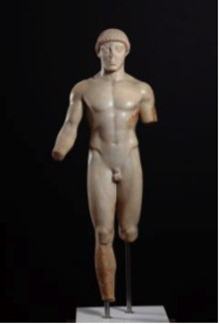The Agrigento Youth, a nude marble statue dating from 480 BC, went on view Wednesday at the Getty Villa as part of the museum's multiyear cultural exchange with Sicily.
 On loan to the Getty through April 19, the artwork, created by an unknown artist, is a rare example of an early classical marble statue called a "kouros," or idealized nude young man. It is being displayed in the Getty Villa's gallery devoted to images of athletes and athletic competition.
On loan to the Getty through April 19, the artwork, created by an unknown artist, is a rare example of an early classical marble statue called a "kouros," or idealized nude young man. It is being displayed in the Getty Villa's gallery devoted to images of athletes and athletic competition.
The artwork comes from the Museo Archeologico Regionale di Agrigento, in southwestern Sicily. The Getty said that pieces of the statue were excavated in the 1800s from two cisterns close to cult precincts devoted to the goddesses Demeter and Persephone, on the slope of the ancient acropolis in what is now modern-day Agrigento.
The Getty's cultural exchange with Sicily was announced in February. The joint project involves object conservation, earthquake protection of collections, exhibitions and more. It's one of a few projects with Italy resulting from the 2007 agreement under which the Getty agreed to transfer 40 objects to Italy in order to help bring to a close the protracted legal battle over disputed works of art.
In June, the Getty received its first major loan from Sicily under the project -- a red-figure wine mixing vessel, or volute-krater, that was produced in Athens sometime between 475-450 BC by the artist known as the Niobid Painter.
The Agrigento Youth is being displayed at the Getty with a custom-built seismic isolation base and pedestal that was made by the museum's conservation team in collaboration with conservators from the Museo Archeologico Regionale. When the sculpture returns to Sicily, it will be accompanied by its new pedestal and earthquake-resistant mount, according to the Getty.
The Getty also has cultural-exchange projects with the National Archaeological Museum of Florence, Italy, and the Museo Archeologico Nazionale in Naples.
Author: David Ng | Source: Los Angeles Times [October 27, 2010]